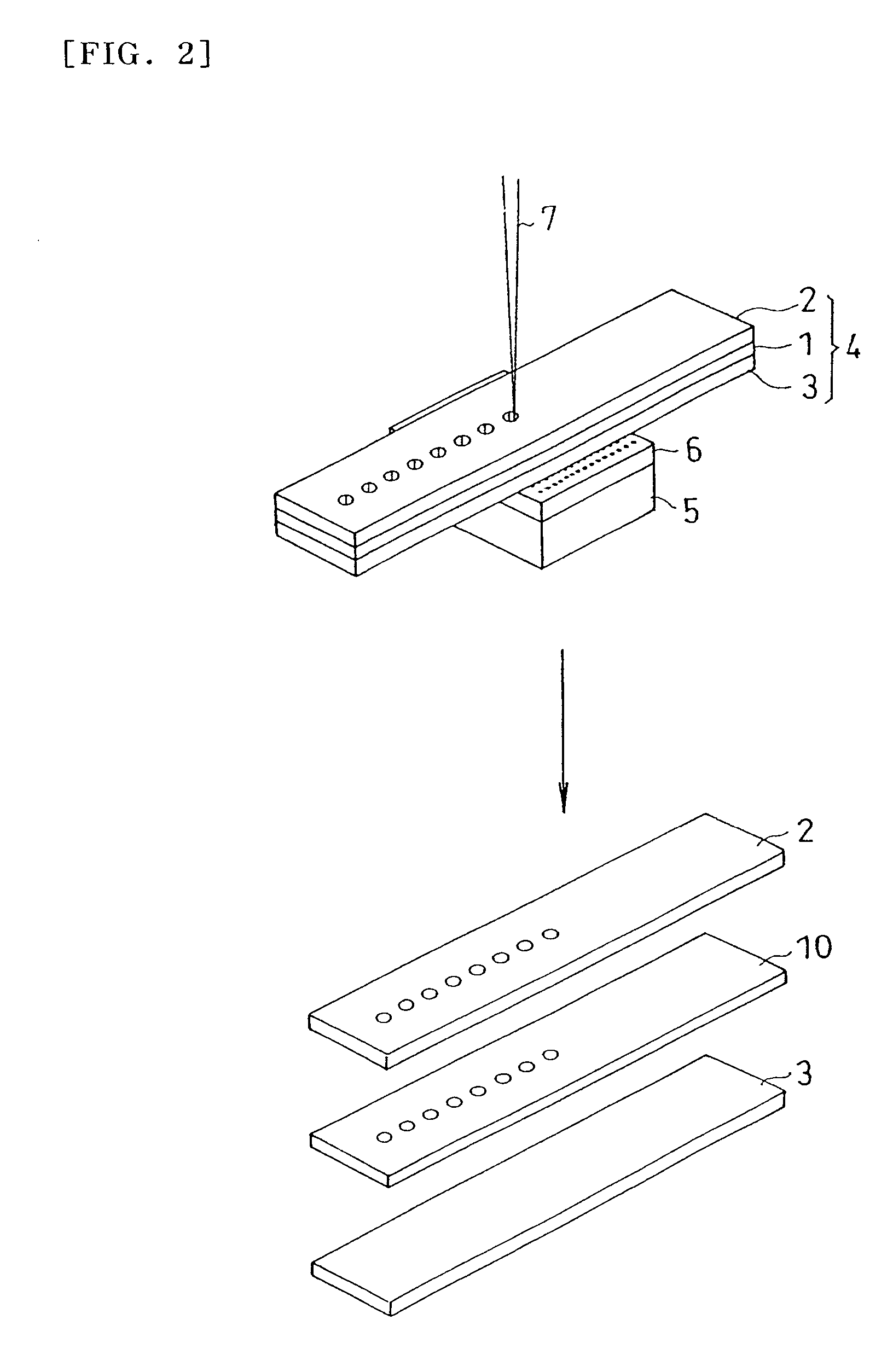Protective sheet for laser processing and manufacturing method of laser processed parts
a technology of laser processing and manufacturing method, applied in the direction of film/foil adhesive, manufacturing tools, transportation and packaging, etc., can solve the problems of difficult to remove aftertreatment deposits, inability to meet demand, and inability to drill or drill with conventional drill or die, so as to achieve effective suppression of contamination of workpiece surface, high precision, and effective suppression of contamination
- Summary
- Abstract
- Description
- Claims
- Application Information
AI Technical Summary
Benefits of technology
Problems solved by technology
Method used
Image
Examples
reference example 1
[0178]The silicon wafer was processed by laser in the same manner as in Example 1, except that polyvinyl alcohol sheet (thickness: 50 μm, light transmissivity at wavelength 355 nm: 84.4%) was used as base material of protective sheet. As a result, the protective sheet was not cut off sufficiently, and the silicon wafer in the lower layer was processed by laser, and foams including decomposition product residue were generated between the protective sheet and silicon wafer. By peeling off the protective sheet, the opening area of the laser beam incident side of the silicon wafer was observed, and sticking of residue of scattering decomposition products of silicon wafer was recognized.
Example 2
[0179]On a base material (thickness: 13 μm, light transmissivity at wavelength 355 nm: 0%) made of polyimide (weight ratio of aromatic ring in repetition unit: 64 wt %), ultraviolet curable acrylic adhesive solution (2) was applied, and dried to form an adhesive layer (thickness 10 μm), and a pro...
example 5
[0185]A base material for protective sheet was manufactured by forming a sheet by casting a polymer obtained by copolymerization of 4-methyl-1-pentyne and 1,4-bis{2-[4-N,N-di(p-tolyl) amino) phenyl]vinyl} benzine at ratio by weight of 97 / 3.
[0186]The flexible printed board was processed by laser in the same manner as in Example 2, except that the above manufactured base material (ratio by weight of aromatic ring in repetition unit: 2.4 wt %, thickness: 10 μm, light transmissivity at wavelength 355 nm: 5%) was used as base material of protective sheet. As a result, cutting of protective sheet and flexible printed board was confirmed. After peeling off the protective sheet, the protective sheet gluing surface of the flexible printed board (the laser beam incident side) was observed particularly in the laser processing area, and decomposition products (deposits) were not observed.
(Second Aspect of the Invention)
[Measurement of Number-Average Molecular Weight]
[0187]Measured in the same m...
example 4
[0201]A polypropylene sheet of 20 μm in thickness was manufactured by mixing 99 parts by weight of polypropylene and 1 part by weight of carbon black, and fusing and extruding.
[0202]The silicon wafer was processed by laser in the same manner as in Example 2, except that the above manufactured polypropylene (etching rate: 0.45) was used as base material of protective sheet. After peeling off the protective sheet, the protective sheet gluing surface of the flexible printed board (the laser beam incident side) was observed particularly in the laser processing area, and decomposition products (deposits) were not observed.
[0203]As clear from the examples and comparisons, by using the protective sheet having a base material of which etching rate is 0.4 or more, contamination of surface of workpiece by decomposition products can be effectively suppressed.
(Third and Fourth Aspects of the Invention)
[Measurement of Number-Average Molecular Weight]
[0204]Measured in the same manner as in the fi...
PUM
| Property | Measurement | Unit |
|---|---|---|
| density | aaaaa | aaaaa |
| extinction coefficient | aaaaa | aaaaa |
| ultraviolet region wavelength λ | aaaaa | aaaaa |
Abstract
Description
Claims
Application Information
 Login to View More
Login to View More - R&D
- Intellectual Property
- Life Sciences
- Materials
- Tech Scout
- Unparalleled Data Quality
- Higher Quality Content
- 60% Fewer Hallucinations
Browse by: Latest US Patents, China's latest patents, Technical Efficacy Thesaurus, Application Domain, Technology Topic, Popular Technical Reports.
© 2025 PatSnap. All rights reserved.Legal|Privacy policy|Modern Slavery Act Transparency Statement|Sitemap|About US| Contact US: help@patsnap.com



